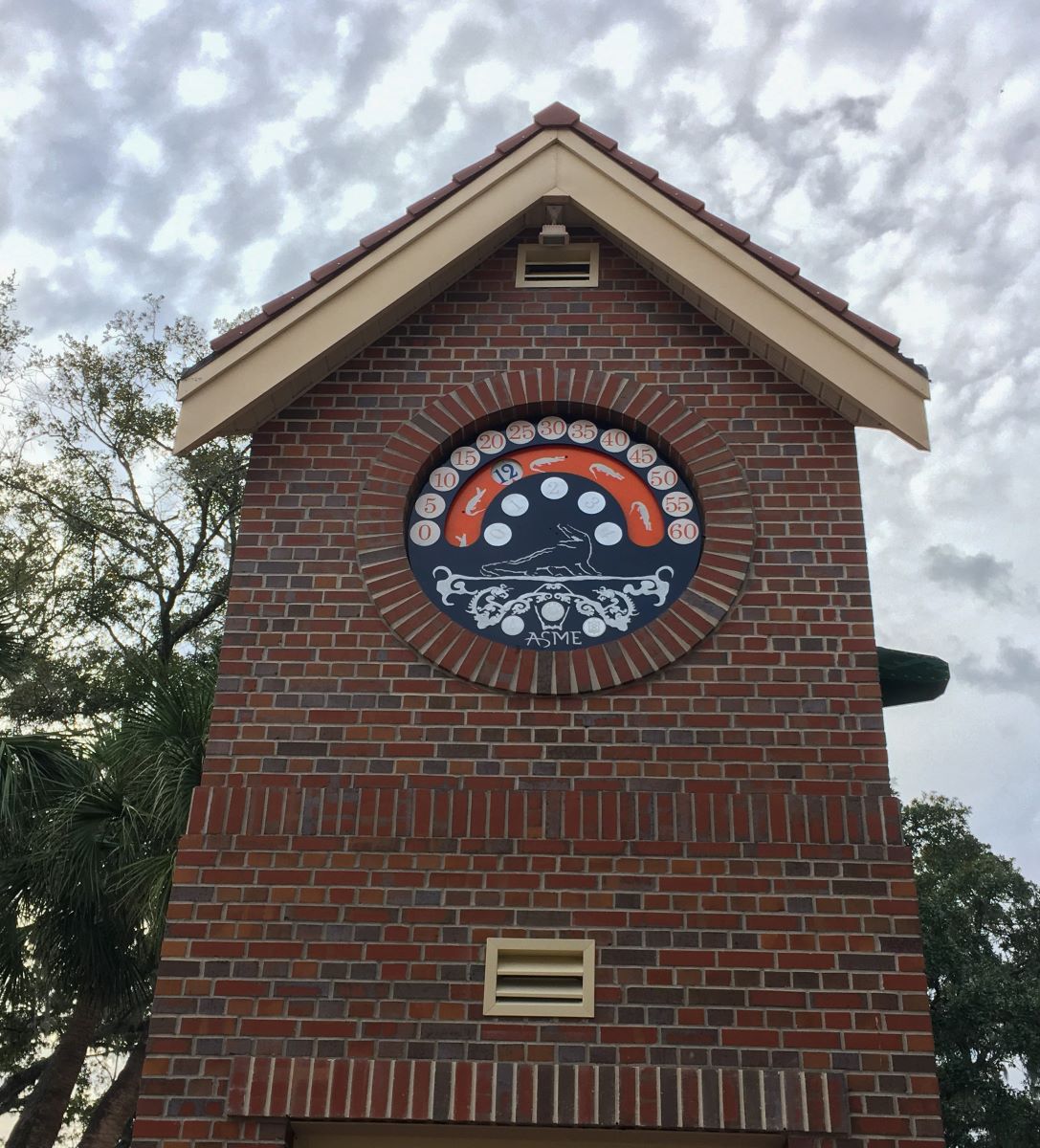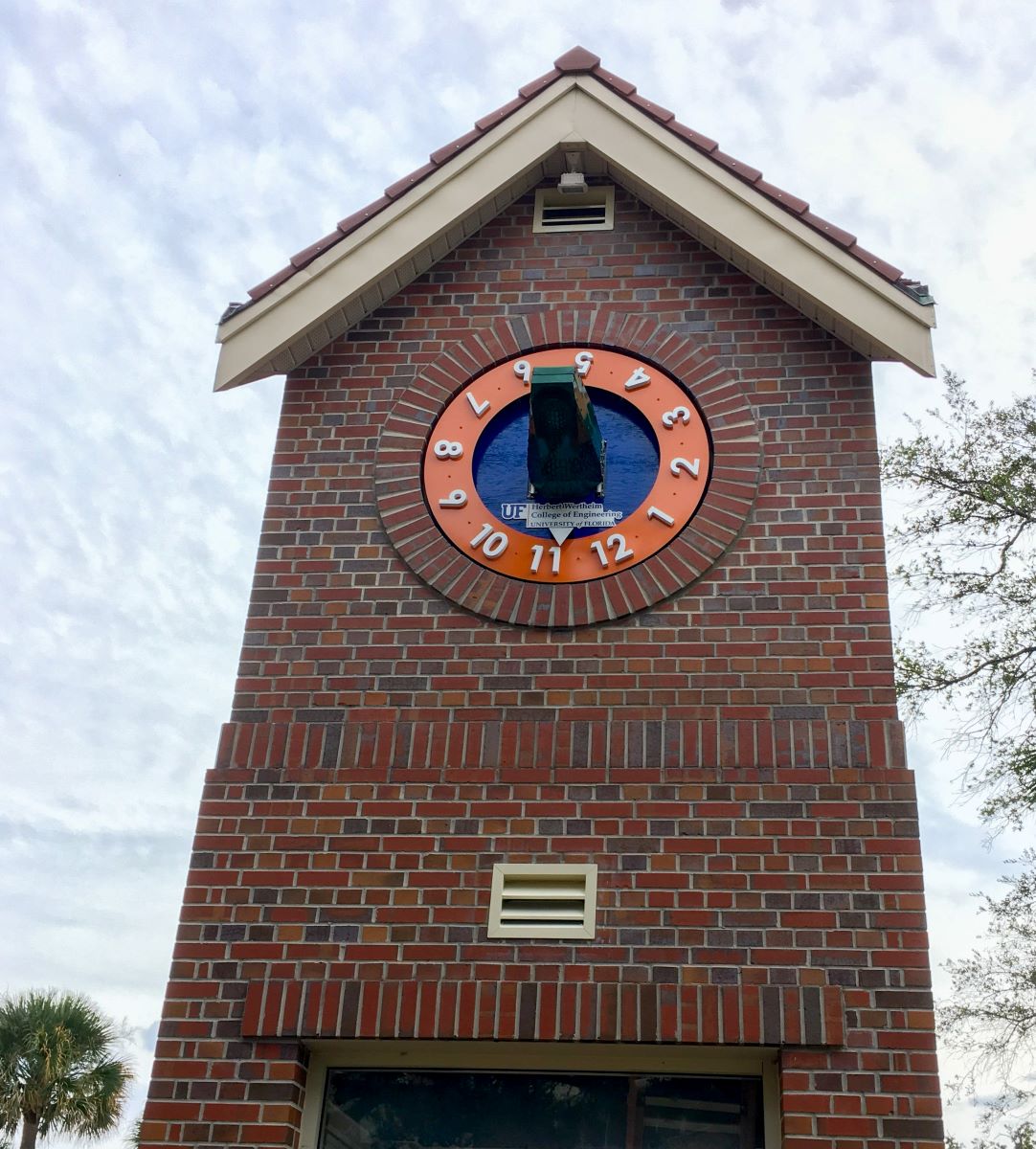Time for a change atop the Weil Hall clock tower
For years, the courtyard in front of Weil Hall, with its clock tower and time capsule, has been a work in progress.
Standing over the busy intersection of Stadium Road and Gale Lemerand Drive across from Ben Hill Griffin Stadium, the tower has pride of place on the University of Florida campus but had not lived up to its potential. Refurbishment on the tower’s two existing clock faces and the design and installation of the other two faces languished as student leads graduated and new students were recruited.
But in October, through the persistence of a relentlessly positive student and his adviser, the clock tower was, for the first time, filled with four clock faces, just in time for a visit from the College of Engineering’s namesake, Herbert Wertheim, Ph.D.
The addition of the Gator Chomp clock face (a UF-themed riff on the cuckoo clock) and the Log10 Clock (time-telling made logarithmic) and the refurbishment of the Binary Clock and the Wandering Dial finally made the Weil Hall clock tower a complete expression of Gator Engineering pride, with a bit of creative nerdiness thrown in for good measure.
Hadyn Rhodes, a master’s student in UF’s Department of Mechanical & Aerospace Engineering, spearheaded efforts to complete the tower in conjunction with his adviser, MAE Professor Mike Griffis, Ph.D. Griffis designed and installed the Log10 Clock.
Fueled by a love of design and no small amount of determination, Rhodes initially took on the project as a sophomore in the fall of 2022. Having recently completed his computer-aided design, or CAD, coursework, he chose the clock tower project when he joined the Student Design Competition team sponsored by the UF Chapter of the American Society of Mechanical Engineers.
Why?
He figured there would be ample opportunity to flex his CAD skills.
Rhodes and the team came up with four design concepts, later combined to two — the Gator Chomp and a later-abandoned Gator racing car. Rhodes handled the CAD work for the Chomp, parts were ordered and work began in earnest.
The cuckoo-style gators are fabricated out of bent aluminum, then riveted together. The clock assembly would be set into an aluminum ring and mounted onto pressure-treated plywood, all held in place with custom clamps and bolts. The clock mechanism is controlled by electronics and motors behind the face. A small gator slides on an 80/20 rail and emerges from the larger gator mouth for the final gator/cuckoo effect.
Though humble, Rhodes will admit he’s “pretty good at bending aluminum.” A previous internship involved fabricating wave energy converters out of aluminum.
Griffis’ Log10 Clock was more of a solo endeavor.
In Rhodes’ telling, Griffis designed and fabricated the entire thing in two weeks in the robotics lab next door to his house. The clock features minute and hour hands that run in opposite directions. Suffice it to say there are some mathematical prerequisites involved in figuring out the correct time.
Rhodes and Griffis made every effort to revitalize the existing clock faces, replacing bulbs in the binary clock, testing and assessing components and doing everything they could to improve the mechanics.
A fully functional clock tower will require more work, however. While the clock faces are up and presiding over the newly renovated courtyard on that corner, they are not yet keeping time.
The newly installed components will require the installation of electrical circuits and wiring and the Binary Clock is lacking the Linux computer hardware necessary to provide the correct time.
How does Rhodes feel, having completed the installation days before the manic deadline of Wertheim’s arrival?
Relieved but proud.
“I have a small bit of my heart attached to this project, I guess,” Rhodes said.




